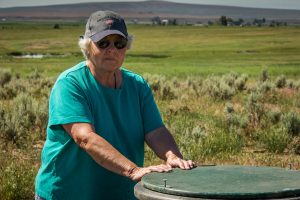
Patricia Damele has seen many challenges in her 50 years of farming but won’t let drought stop her operation.
By: Kaylyn Franks, District Director, Idaho Farm Service Agency
Charles and Patricia Damele have jumped their share of hurdles when it comes to farming.
With nearly 300 cattle and 560 acres of hay and pasture in Northern Idaho, they have battled low cattle prices, high hay costs and have fought off plenty of insects and rodents in their 50 years of farming.
But one of the toughest fights they’ve encountered is the drought that has affected the entire state of Idaho for several years. On top of that, Charles has suffered health problems, leaving most of the work to Patricia and her son, Paul.
“The lack of snowfall over the past couple of years has drastically reduced the availability of water,” said Patricia, who has a reservoir that is used to provide water for livestock. “We had to pay for water to be hauled to the ranch for the past two years, but it became increasingly expensive.”
It wasn’t until Patricia had a conversation with a neighbor that she turned to the U.S. Department of Agriculture (USDA) Farm Service Agency (FSA) for help and learned about the Emergency Conservation Program (ECP).
ECP helps farmers and ranchers repair damage to farmland caused by natural disasters and helps put in place methods for water conservation during severe drought. FSA teams up with the USDA Natural Resources Conservation Service (NRCS) to provide repairs to the land and to install methods of water conservation.
Patricia met with Tom Snow, FSA County Executive Director, who determined that she qualified for a well and livestock troughs. She was then referred to NRCS for the technical design that consisted of an enclosed well and two watering troughs connected by underground pipeline. The troughs and pump house have electrical outlets allowing Patricia to plug heaters in during the winter to prevent ice from forming.
“The last thing she needed to be doing was breaking ice in the winter for those cattle. This design would help accomplish this goal,” said Katie Dennis, NRCS soil technician.
Ironically, the installation occurred during one of the best rainfalls the area had experienced in years, creating a muddy mess for the well driller, but it was a successful endeavor.
“The well will provide a consistent and clean source of drinking water for her livestock,” said Snow.
Now that Patricia no longer has to worry about watering her livestock, she can focus on the other challenges, like grasshoppers, aphids and voles. But the livestock watering system has made her operation a little bit stronger.
“I’m 71 years old and should probably retire, but I just love ranching and being outdoors. I’ll take it any day over housecleaning! I plan to keep ranching as long as I can,” said Patricia.
For more information on how FSA can assist with drought and other disasters, visit http://disaster.fsa.usda.gov. To learn more about the FSA Emergency Conservation Program, visit www.fsa.usda.gov/conservation, or contact your local FSA office. You can find your local FSA office by visiting http://offices.usda.gov.





